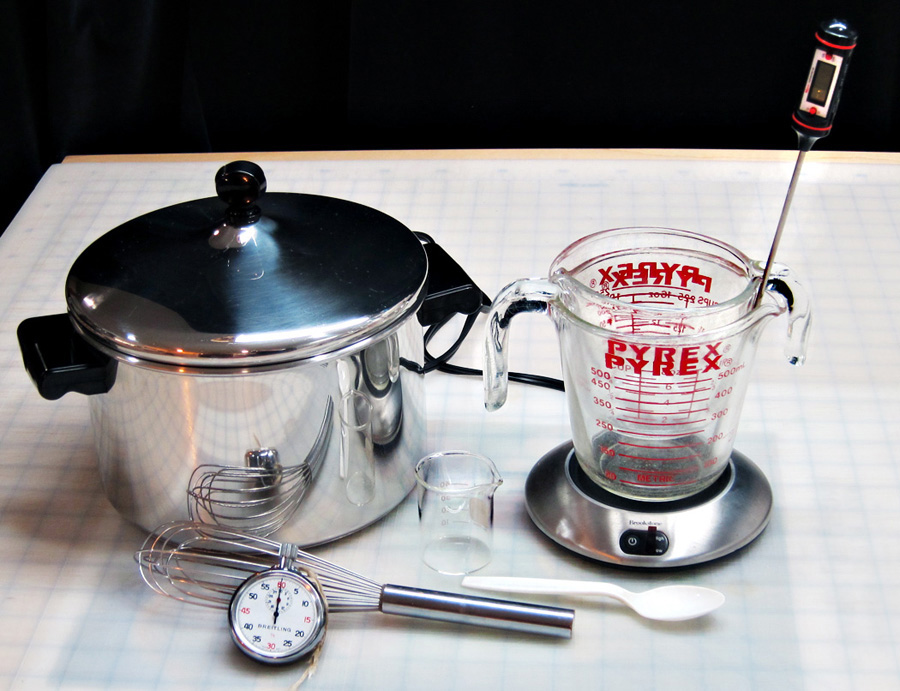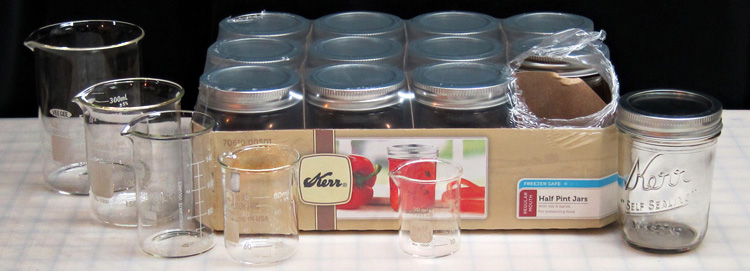6. Getting Started—Tools and Materials

OK, time to get down to it and make a shopping/scrounging list. Don't be intimidated by the length of the list. Almost every item will be used again and again with many different recipes—along with the addition of a few more chemicals and perhaps more lab equipment. Remember to think in terms of purpose and function, not exact form.
The set-up shown above will be used for the first emulsion recipe.
The first recipe calls for 3 g of potassium chloride, 5 g of silver nitrate, and 25 g of gelatin. That should give you an idea of the quantities you'd like to order. I use 2½ sheets of 22"x 30" watercolor paper per batch of emulsion. That's assuming ten 11"x 15" individual sheets, coated with a 9-inch puddle pusher.
- Distilled Water
- Photographic gelatin (Hard 250 Bloom)
- Potassium chloride (KCl)
- Silver nitrate (AgNO3)
- Photoflo 200
- Everclear, or unflavored vodka (since Everclear is available for sale online, I recommend it over vodka)
- Scale accurate to 0.01 g
- 1-cup/ 250 ml Pyrex measuring cup
- 2-cup/ 500 ml Pyrex measuring cup
- Small beaker (80 or 100 ml) or similar small glass that pours cleanly
- Thermometer
- Small stainless steel whisk
- 10 ml or 25 ml graduated cylinder (or kitchen tablespoon)
- Timer (darkroom or kitchen countdown timer, or stopwatch)
- Small bottle and an eye dropper (ideally, a bottle with a dropper lid—brown glass is best)
- Wash bottle or squeeze bottle for adding precise amounts of water
- Plastic wrap and rubber bands
- Plastic spoons
- Disposable gloves, latex or nitrile (not powdered)
- Eye protection
- Old clothes and/or an apron
- A selection of old towels and rags, including one bath towel
- Paper towels
- String of red LED mini-lights, or a 25 watt yellow 'bug light'
- Kitchen pot with tight, lightproof lid—big enough to hold two stacked Pyrex cups
- Heat source for a waterbath (pictured above is a coffee mug warmer made by 'Brookstone')
- Watercolor paper, cut and coded for grain orientation. We are starting with 90 lb HP paper ("HP" for Hot Press, i.e., smooth)—Arches and/or Fabriano Artistico Traditional White.
- Clean tray big enough to soak the watercolor paper in its final coating size
- Sheet of Mylar, Dura-lar, or similar (a little bigger than the watercolor paper cut to its final coating size
- Squeegee
- Scoop (~ ¼ cup/2 oz /50-60 ml)
- Plastic bowl or tray for hot water to rinse the puddle pusher between coatings
- Clothesline for hanging paper to dry
- Papersafe, or lightproof bag for storing dry, unexposed printing paper
- Processing chemistry: developer, stop bath, and hypo (non-hardening fix), and optionally, selenium toner
- Trays for processing and washing prints
- Glass surface(s). NOTE: What this means will be explained on the next page.
- Two glass puddle pushers, ends wrapped and plugged (plastic tape and wall hanging putty). See that first two illustrations here for more information. I will be coating with a 9-inch puddle pusher.The reason to have two is for backup. Accidents happen and glass breaks. Few things are more frustrating than finding yourself in middle of coating without a coater.
- Space required: a dark'able room. A hall bathroom that can be left alone for a day at a time is ideal. Go here for ideas.
- [October 2018 update: In the years since these lessons were first written, I've gone almost exclusively to wet paper coating with emulsion guide bars. For more information about the technique, please go to The Light Farm book, available to read for free in Blurb preview,
pp 35-36.]
A Few More Notes
If you keep at this, you'll probably end up with a collection of graduated cylinders. They are not expensive, they are very handy, and who could resist? They are very nifty. But, you don't technically need one. The great thing about water is that it is the "baseline" for weights and volumes. 1 ml (milliliter) of water equals 1 g (gram) of water. So, if you need 100 ml of water, you can weigh out 100 g of water.
The first recipe calls for 15 ml Everclear. I always measure it out in a 25 ml graduated cylinder, but 15 ml is the volume of 1 tablespoon or 3 teaspoons. The recipe isn't so finicky about the Everclear that you couldn't just use a kitchen tablespoon.

A running joke among my family and friends is that I always have my eyes open for something that could be used for making emulsions. Kitchen stores, hardware stores, secondhand stores—all potential sources of great gadgets. I bought a half dozen small rubber scrapers at a local hardware store in Minnesota that I couldn't be without. During a Christmas shopping, I found a little gem made by Anchor brand. It's a graduate for the kitchen, marked in mls up to 150, ounces, and tablespoons. I calibrated all the ml markings against a lab graduate and they were spot on. It cost $1.89. I've started using it for a lot of measuring because it's short and heavy-bottomed, making it very stable.
Many of the things I've found haven't been worth the space they take up and it's been off to the Humane Society thrift store for them. This is the way it will be for you, too. You will start from the list I've made of things that work for me, but you'll soon start to make your own list—one that fits your art and workflow.
One last thing: If you already have a magnetic stirring hot plate, or if you are so sure you'll be going forward with emulsion making that you're ready to invest in one now, you can certainly use it as your heat source. If you want to use magnetic stirring to make the emulsion, you will need a different waterbath set-up than stacked Pyrex cups. They are too thick for the magnetic fields of most stirrers to affect the stirring bar. You'll want either a 250 ml glass beaker, an 8 ounce canning jar, or similar. The first recipe will have two variations: one for the set-up shown on this page and one for a magnetic hot plate.

